Joshua trees (Yucca brevifolia) — backed by granite monoliths — are the marquee celebrities of Joshua Tree National Park.

However, the park spans two deserts (Mojave and Colorado), a range of elevations between 2,000 and 5,800 feet, encompassing a variety of landscapes and multiple ecosystems with diverse plant and animal life.
In the transition zone between the higher Mojave and the lower Coloradan deserts, a long eastward slope from the Hexie Mountains into the Pinto Basin is a perfect environment for Cylindropuntia bigelovii, the Teddy Bear Cholla.
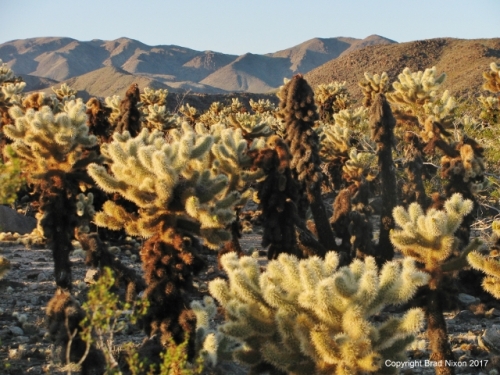
The area is named the Cholla Cactus Garden (blue circle on map).
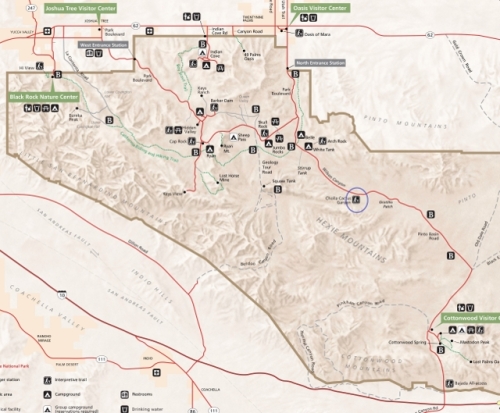
There’s a level, easy nature trail through the cholla, immediately accessible from a parking lot along the road that leads southeastward from the upper portion of the park to Cottonwood Spring. Click here for the map on the NPS site.
Cholla cacti are common throughout the Sonora Desert (of which the Colorado is a part), and you’re likely to encounter them in southern California, portions of Arizona and New Mexico and northwestern Mexico.
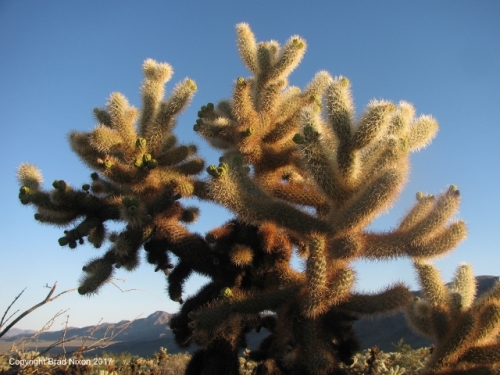
Do not attempt to “encounter” them too closely. Despite the cute name, they aren’t at all “fuzzy;” those spines are extremely sharp and will easily pierce your clothing and then your skin with extreme prejudice.
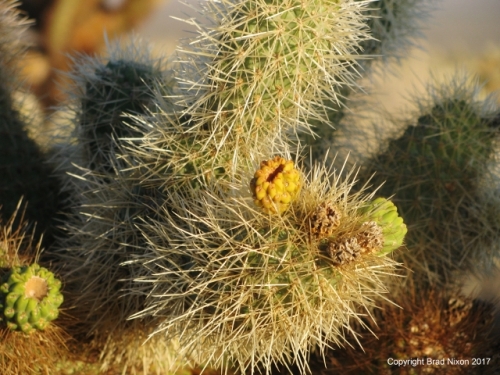
One of my favorite aspects of hiking the southwestern deserts is the light gilding the cactus spines.
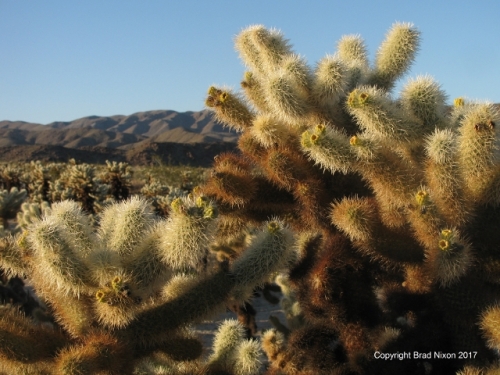
To take advantage of that phenomenon, we made a point of getting to the Cholla Cactus Garden just as the setting sun was about to touch the top of the mountains, shining almost horizontally through the expanse of cacti. The scene exceeded our expectations.

To the east, the basin was still in full sun, backed by the Pinto Mountains.
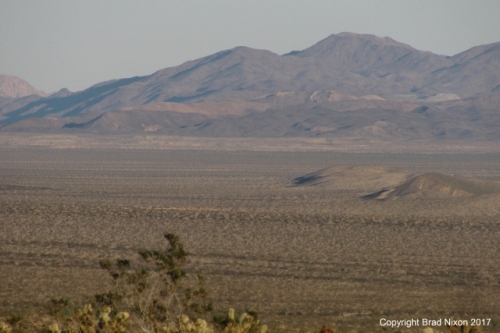
As compelling as that view was, my attention was riveted by the cacti.
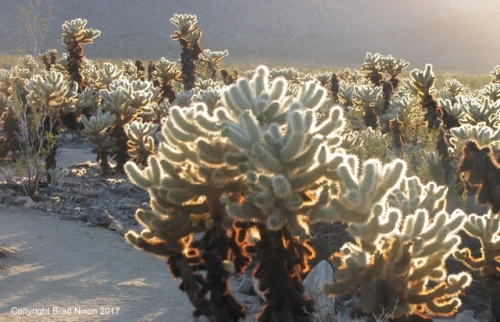

An interesting aspect of the cholla life cycle is visible on the ground. The cacti are surrounded by small “cholla balls.” (click on these images to enlarge)
They’re pieces of cacti that have broken off. Many take root and grow into separate plants.
You’ll typically see cholla from 1 to 5 feet tall, but as this photo shows, they can grow higher than I can reach, which is about 8 feet.
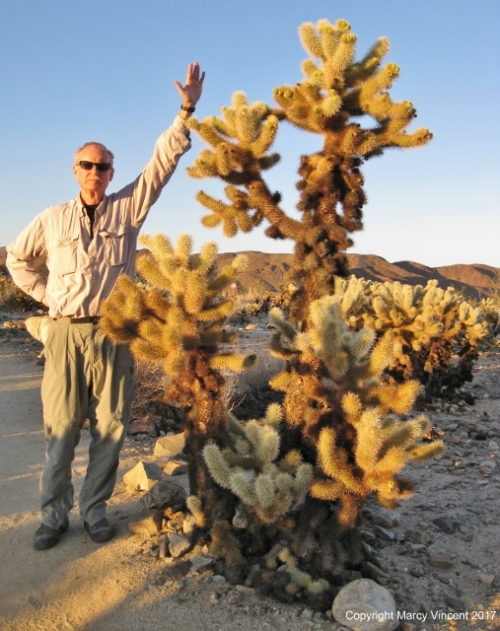
The desert is always changing, everlastingly beautiful.
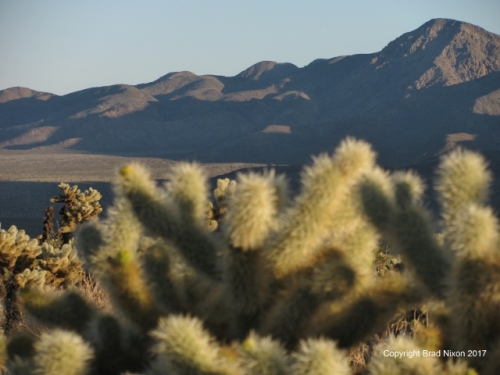
Joshua Tree is extremely large: more than 1,200 square miles, much of it true wilderness. Don’t try to see everything by spending all your time driving: You’ll fail, and miss the best thing, which is finding some places to get out and let the park embrace you — it’s too vast for you to embrace it.
As I’ve said many times before, one of the consolations of the natural world is the silence. In Joshua Tree, as everywhere, it’s sometimes enough to simply stand and admire how the light falls.
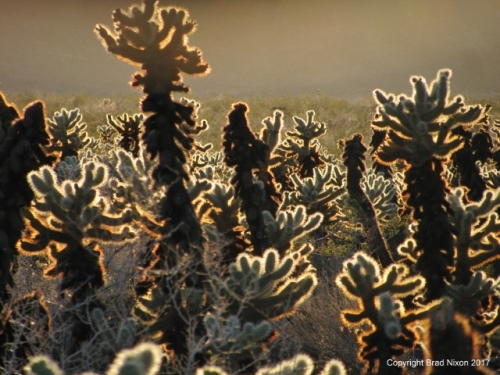
Two recent posts from Joshua Tree NP:
JTNP, Pictures Are Not the World
JTNP: Valentine Greeting from the Desert (including more cactus varieties)
To U.S. readers: The current administration is arming itself to eviscerate a broad swath of protections and support for clean water and air, wild lands and public well-being. As you learn of such actions, call your elected representatives and express your opposition, and your reasons. Remind them you’ll be voting in the next election. Thank you.
© Brad Nixon 2017. Photo of me measuring cactus © Marcy Vincent 2017, used by kind permission.


“Otherworldly” is the word that comes to mind. Joshua Tree has been little more than an album title for me, but I’m developing an interest in and appreciation for what’s there in the NP. All of your photos are impressive, but those little cholla balls are cute.
LikeLike
By: shoreacres on March 15, 2017
at 6:08 am
Interestingly, that U2 photo was shot 200 miles away, not in JTNP.
LikeLiked by 1 person
By: Brad Nixon on March 15, 2017
at 7:43 am
Thank you for the call to action to preserve this and the many other precious wilderness places under attack.
I urge everyone who values these irreplaceable lands and sanctuaries of the human spirit to add your persistent voice for their protection. You will not be alone. The NRDC and Sierra Club, with a groundswell of members, are key organizations you can support to join others in taking strategic action.
LikeLike
By: Marcy Vincent on March 15, 2017
at 1:22 pm
Thank you. That’s http://www.nrdc.org and sierraclub.org.
LikeLike
By: Brad Nixon on March 15, 2017
at 1:24 pm
Amazing. I wish to come in the United States to visit the National Park.
LikeLike
By: teabeestrips on March 16, 2017
at 2:24 am
I hope you will.
LikeLiked by 1 person
By: Brad Nixon on March 16, 2017
at 3:37 am
Incredible… This is so different of the plants we used to see in Europe. The light on the spines is amazing. I find one of your comment on Tea Bee’s Trips Blog where I read that you are learning French, good luck ! Incroyable… C’est tellement différent des plantes que l’on a l’habitude de voir en Europe… La lumière sur les épines est magnifique. J’ai trouvé un de tes commentaire sur le blog Tea Bee’s Trips où j’ai lu que tu étais en train d’apprendre le Français, bonne chance ! 🙂
LikeLike
By: Rotdenken on March 16, 2017
at 2:27 pm
Merci. I won’t attempt to answer in French. Soon, I hope, but not yet. Thank you very much for the dual language response.
LikeLiked by 1 person
By: Brad Nixon on March 16, 2017
at 10:36 pm
It’s beautiful… Wish to visit the park some day
LikeLike
By: Untraveled Routes on March 18, 2017
at 9:55 pm
Easily reached from Los Angeles – just over 2 hours away.
LikeLiked by 1 person
By: Brad Nixon on March 18, 2017
at 11:13 pm